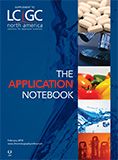The Grass Isn’t Always Greener: Removal of Purple Pigmentation from Cannabis Using QuEChERS Extraction and Chlorofiltr® dSPE Cleanup
The Application Notebook
Cannabis testing laboratories have the challenge of removing a variety of unwanted matrix components from plant material prior to running extracts on their LC–MS/MS or GC–MS. The complexity of the cannabis plant presents additional analytical challenges that do not need to be accounted for in other agricultural products. While novel methods have been developed for the removal of chlorophyll, few sample preparation methods, if any, have been devoted to removal of other colored pigments from other popular cannabis strains.


Figure 1: Cannabis strains used (clockwise from top left): Agent Orange, Tahoe OG, Blue Skunk, Grand Daddy, and Grape Drink.
Procedure
Sample Extraction
a) Add 1 g of cannabis + 10 mL H2O
b) Vortex briefly and hydrate for 10 min.
c) Add 10 mL ACN + 2% formic acid + the QuEChERS extraction salts from the Mylar pouch (ECMSSC50CT-MP) to the 50-mL tube, and shake vigorously for 1 min manually or using a Spex 2010 Geno-Grinder at 1000 strokes/min.
d) Centrifuge at ≥3000 rcf for 5 min.
e) Transfer 1 mL supernatant to SpinFiltr® dSPE cleanup tube.
f) Vortex for 30 s and centrifuge at ≥3000 rcf for 2 min.
g) Transfer purified and filtered extract into autosampler vial for analysis.

Figure 2: Cannabis samples following hydration. Left: Grape Drink Strain, right: Agent Orange Strain.
Instrumental

Conclusion
A blend of MgSO4, C18, PSA, and Chlorofiltr® allowed for the most effective sample clean up, without loss of pesticides and mycotoxins, for all cannabis samples tested. Average recovery of the 48 pesticides and four mycotoxins using the selected dSPE blend was 75.6% where as the average recovery when including GCB instead of Chlorofiltr® was 67.6%. Regardless of the sample's original pigmentation, this blend successfully removed both chlorophyll and purple hues from all strains tested. The other six dSPE blends evaluated were unable to provide the sample clean up needed or had previously demonstrated to be detrimental to the recovery of pesticides routinely analyzed for in cannabis.

UCT, LLC
2731 Bartram Rd, Bristol, PA 19007
tel: (800) 385-3153
Website: www.unitedchem.com

Analytical Challenges in Measuring Migration from Food Contact Materials
November 2nd 2015Food contact materials contain low molecular weight additives and processing aids which can migrate into foods leading to trace levels of contamination. Food safety is ensured through regulations, comprising compositional controls and migration limits, which present a significant analytical challenge to the food industry to ensure compliance and demonstrate due diligence. Of the various analytical approaches, LC-MS/MS has proved to be an essential tool in monitoring migration of target compounds into foods, and more sophisticated approaches such as LC-high resolution MS (Orbitrap) are being increasingly used for untargeted analysis to monitor non-intentionally added substances. This podcast will provide an overview to this area, illustrated with various applications showing current approaches being employed.















